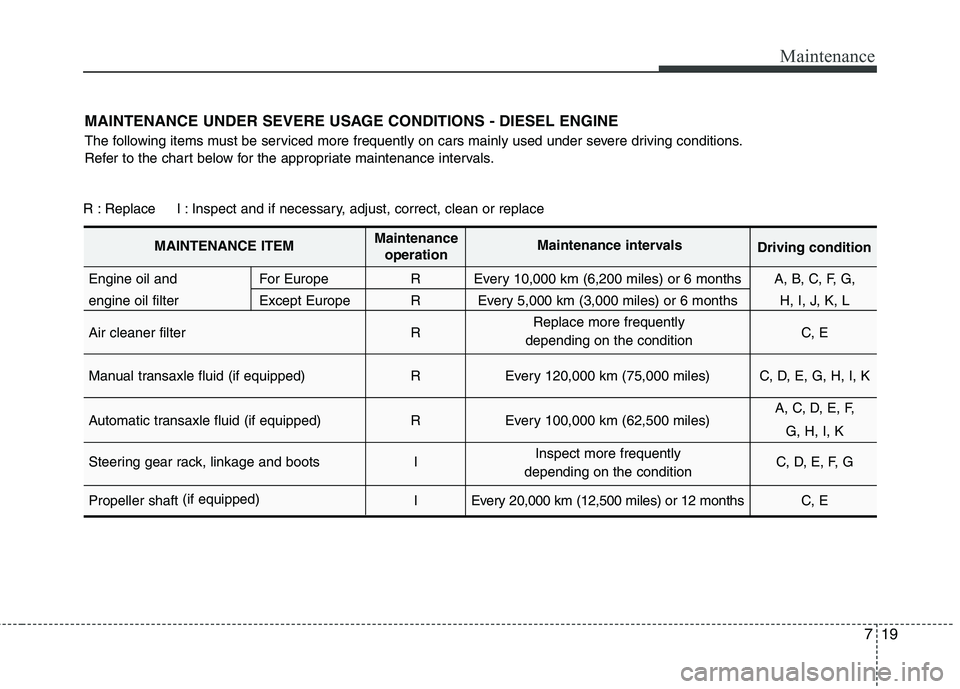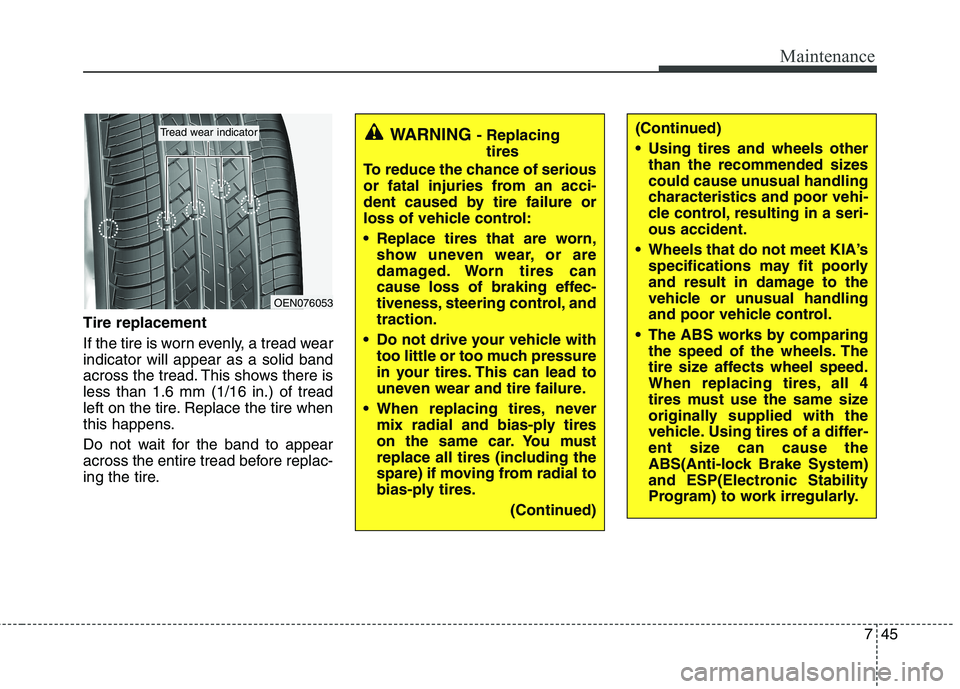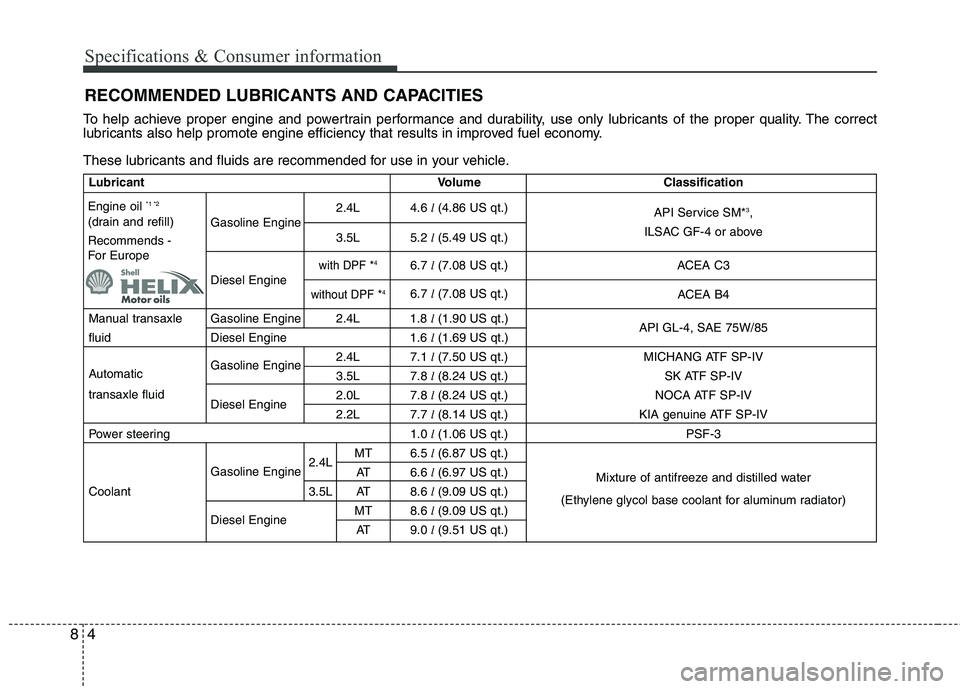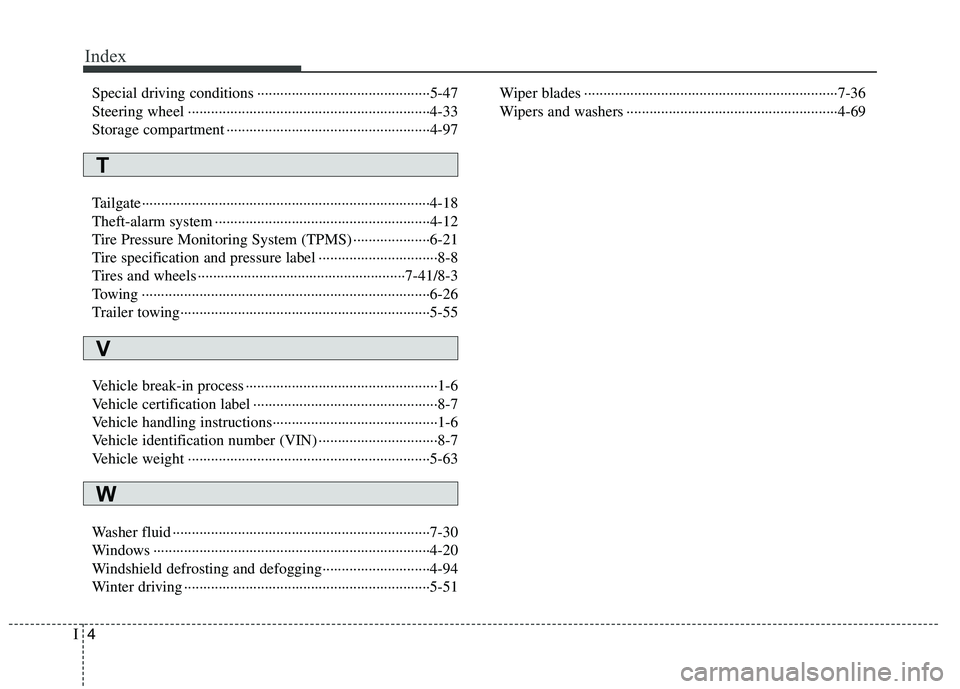2010 KIA SORENTO steering
[x] Cancel search: steeringPage 325 of 399

719
Maintenance
MAINTENANCE UNDER SEVERE USAGE CONDITIONS - DIESEL ENGINE
The following items must be serviced more frequently on cars mainly used under severe driving conditions.
Refer to the chart below for the appropriate maintenance intervals.
R : Replace I : Inspect and if necessary, adjust, correct, clean or replace
MAINTENANCE ITEMMaintenance
operation Maintenance intervals
Driving condition
Replace more frequently
depending on the condition
Engine oil and For Europe R Every 10,000 km (6,200 miles) or 6 months A, B, C, F, G,
engine oil filter Except Europe R Every 5,000 km (3,000 miles) or 6 months H, I, J, K, L
Air cleaner filter R
C, E
Manual transaxle fluid (if equipped) R Every 120,000 km (75,000 miles) C, D, E, G, H, I, K
Automatic transaxle fluid (if equipped) R Every 100,000 km (62,500 miles) A, C, D, E, F,
G, H, I, K
Steering gear rack, linkage and boots I C, D, E, F, G
Propeller shaft (if equipped)
I Every 20,000 km (12,500 miles) or 12 months C, E
Inspect more frequently
depending on the condition
Page 329 of 399

723
Maintenance
Brake hoses and lines
Visually check for proper installation,
chafing, cracks, deterioration and any
leakage. Replace any deteriorated or
damaged parts immediately. Brake fluid
Check the brake fluid level in the brake
fluid reservoir. The level should be
between “MIN” and “MAX” marks on the
side of the reservoir. Use only hydraulic
brake fluid conforming to DOT 3 or DOT4 specification.
Parking brake
Inspect the parking brake system includ-
ing the parking brake pedal and cables.
Brake discs, pads, calipers and
rotors
Check the pads for excessive wear, discs
for run out and wear, and calipers for fluid
leakage.Suspension mounting bolts
Check the suspension connections for
looseness or damage. Retighten to the
specified torque.
Steering gear box, linkage &
boots/lower arm ball joint
With the vehicle stopped and engine off,
check for excessive free-play in the
steering wheel.
Check the linkage for bends or damage.
Check the dust boots and ball joints for
deterioration, cracks, or damage.
Replace any damaged parts.
Power steering pump, belt and hoses
Check the power steering pump and
hoses for leakage and damage. Replace
any damaged or leaking parts immedi-
ately. Inspect the power steering belt (or
drive belt) for evidence of cuts, cracks,
excessive wear, oiliness and proper ten-
sion. Replace or adjust it if necessary.Drive shafts and boots
Check the drive shafts, boots and clamps
for cracks, deterioration, or damage.
Replace any damaged parts and, if nec-
essary, repack the grease.
Air conditioning refrigerant (if equipped)
Check the air conditioning lines and con-
nections for leakage and damage.
Page 335 of 399

729
Maintenance
POWER STEERING FLUID
Checking the power steering fluid
level
With the vehicle on level ground, check
the fluid level in the power steering reser-
voir periodically. The fluid should be
between MAX and MIN marks on the
side of the reservoir at the normal tem-
perature.
Before adding power steering fluid, thor- oughly clean the area around the reser-
voir cap to prevent power steering fluidcontamination.
If the level is low, add fluid to the MAX
level.
✽✽ NOTICE
Check that the fluid level is in the
"HOT" range on the reservoir. If the
fluid is cold, check that it is in the
"COLD" range.
In the event the power steering system requires frequent addition of fluid, the
vehicle should be inspected by an
authorized KIA dealer.
Use only the specified power steering fluid. (Refer to "Recommended lubricants or capacities" in section 8.)
Checking the power steering hose
Check the connections for oil leaks, dam-
age and twists in the power steering
hose before driving.
CAUTION
To avoid damage to the power
steering pump, do not operate thevehicle for prolonged periodswith a low power steering fluidlevel.
Never start the engine when the reservoir tank is empty.
When adding fluid, be careful that dirt does not get into the tank.
Too little fluid can result in increased steering effort and/or
noise from the power steeringsystem.
The use of the non-specified fluid could reduce the effectiveness ofthe power steering system and
cause damage to it.OXM079009
Page 351 of 399

745
Maintenance
Tire replacement
If the tire is worn evenly, a tread wear indicator will appear as a solid band
across the tread. This shows there isless than 1.6 mm (1/16 in.) of tread
left on the tire. Replace the tire when
this happens.
Do not wait for the band to appear
across the entire tread before replac-
ing the tire.
OEN076053
Tread wear indicatorWARNING - Replacing
tires
To reduce the chance of serious
or fatal injuries from an acci-
dent caused by tire failure or
loss of vehicle control:
Replace tires that are worn, show uneven wear, or are
damaged. Worn tires can
cause loss of braking effec-
tiveness, steering control, andtraction.
Do not drive your vehicle with too little or too much pressure
in your tires. This can lead to
uneven wear and tire failure.
When replacing tires, never mix radial and bias-ply tires
on the same car. You must
replace all tires (including the
spare) if moving from radial to
bias-ply tires.
(Continued)(Continued)
Using tires and wheels otherthan the recommended sizes
could cause unusual handling
characteristics and poor vehi-
cle control, resulting in a seri-ous accident.
Wheels that do not meet KIA’s specifications may fit poorly
and result in damage to the
vehicle or unusual handling
and poor vehicle control.
The ABS works by comparing the speed of the wheels. The
tire size affects wheel speed.
When replacing tires, all 4
tires must use the same size
originally supplied with the
vehicle. Using tires of a differ-
ent size can cause the
ABS(Anti-lock Brake System)
and ESP(Electronic Stability
Program) to work irregularly.
Page 383 of 399

777
Maintenance
Interior care
Interior general precautions
Prevent caustic solutions such as per- fume and cosmetic oil from contacting
the dashboard because they may cause
damage or discoloration. If they do con-tact the dashboard, wipe them off imme-
diately. See the instructions for the prop-
er way to clean vinyl.
Cleaning the upholstery and interiortrim
Vinyl
Remove dust and loose dirt from vinyl
with a whisk broom or vacuum cleaner.
Clean vinyl surfaces with a vinyl cleaner.
Fabric
Remove dust and loose dirt from fabric
with a whisk broom or vacuum cleaner.Clean with a mild soap solution recom-
mended for upholstery or carpets.
Remove fresh spots immediately with a
fabric spot cleaner. If fresh spots do not
receive immediate attention, the fabriccan be stained and its color can be
affected. Also, its fire-resistant properties
can be reduced if the material is not
properly maintained.
Cleaning the lap/shoulder belt web-bing
Clean the belt webbing with any mild
soap solution recommended for cleaning
upholstery or carpet. Follow the instruc-
tions provided with the soap. Do not
bleach or re-dye the webbing because
this may weaken it.
Cleaning the interior window glass
If the interior glass surfaces of the vehi-
cle become fogged (that is, covered with
an oily, greasy or waxy film), they should
be cleaned with a glass cleaner. Followthe directions on the glass cleaner con-
tainer.CAUTION
Never allow water or other liquids
to come in contact withelectrical/electronic componentsinside the vehicle as this may dam-age them.
CAUTION
When cleaning leather products
(steering wheel, seats etc.), useneutral detergents or low alcoholcontent solutions. If you use highalcohol content solutions or
acid/alkaline detergents, the color of the leather may fade or the sur-face may get stripped off.CAUTION
Using anything but recommended
cleaners and procedures may affectthe fabric’s appearance and fire-resistant properties.
CAUTION
Do not scrape or scratch the insideof the rear window. This may result in damage of the rear windowdefroster grid.
Page 391 of 399

Specifications & Consumer information
4
8
RECOMMENDED LUBRICANTS AND CAPACITIES
To help achieve proper engine and powertrain performance and durability, use only lubricants of the proper quality. The correct
lubricants also help promote engine efficiency that results in improved fuel economy.
These lubricants and fluids are recommended for use in your vehicle.
Lubricant Volume Classification
2.4L 4.6 l (4.86 US qt.)
API Service SM*3
,
Gasoline Engine
3.5L 5.2 l (5.49 US qt.) ILSAC GF-4 or above
with DPF *
46.7
l (7.08 US qt.) ACEA C3
Diesel Engine 6.7 l (7.08 US qt.)
without DPF * 4ACEA B4
Manual transaxle Gasoline Engine 2.4L 1.8 l(1.90 US qt.)
API GL-4, SAE 75W/85
fluid Diesel Engine 1.6 l(1.69 US qt.)
Automatic 2.4L 7.1
l (7.50 US qt.) MICHANG ATF SP-IV
transaxle fluid Gasoline Engine
3.5L 7.8 l (8.24 US qt.) SK ATF SP-IV
Diesel Engine 2.0L 7.8
l (8.24 US qt.) NOCA ATF SP-IV
2.2L 7.7 l (8.14 US qt.) KIA genuine ATF SP-IV
Power steering 1.0 l (1.06 US qt.) PSF-3
Gasoline Engine 2.4LMT 6.5
l (6.87 US qt.)
Mixture of antifreeze and distilled water
AT 6.6
l (6.97 US qt.)
Coolant 3.5L AT 8.6 l (9.09 US qt.)
Diesel Engine MT 8.6
l (9.09 US qt.) (Ethylene glycol base coolant for aluminum radiator)
AT 9.0 l (9.51 US qt.)
Engine oil *1 *2
(drain and refill) Recommends -
For Europe
Page 398 of 399

I3
Index
If the engine overheats·····················································6-6
If the engine will not start ···············································6-3
If you have a flat tire
(with InstantMobilitySystem)······································6-16
If you have a flat tire (with spare tire)·····························6-7
In case of an emergency while driving ····························6-2
Indicator symbols on the instrument cluster ···················1-7
Instrument cluster ··························································4-39
Instrument panel overview···············································2-3
Interior features······························································4-99
Interior light ···································································4-73
Interior overview······························································2-2
Key positions ···································································5-4
Keys ·················································································4-3
Light bulbs ·····································································7-63
Lighting··········································································4-63
Maintenance services ·······················································7-4 Manual climate control system······································4-77
Manual transaxle····························································5-14
Mirrors ···········································································4-35
Owner maintenance ·························································7-6
Panorama sunroof ··························································4-29
Parking brake ································································7-30
Power steering fluid ·······················································7-29
Rear parking assist system·············································4-59
Rearview camera····························································4-62
Recommended lubricants and capacities ·························8-4
Remote keyless entry ·······················································4-6
Road warning ···································································6-2
Scheduled maintenance service ·······································7-8
Seat belts ········································································3-18
Seats ·················································································3-2
Smart key ·········································································4-9
I
K
L
M
P
O
R
S
Page 399 of 399

Index
4
I
Special driving conditions ·············································5-47
Steering wheel ·······························································4-33
Storage compartment ·····················································4-97
Tailgate···········································································4-18
Theft-alarm system ························································4-12
Tire Pressure Monitoring System (TPMS) ····················6-21
Tire specification and pressure label ·······························8-8
Tires and wheels ······················································7-41/8-3
Towing ···········································································6-26
Trailer towing·································································5-55
Vehicle break-in process ··················································1-6
Vehicle certification label ················································8-7
Vehicle handling instructions···········································1-6
Vehicle identification number (VIN) ·······························8-7
Vehicle weight ·······························································5-63
Washer fluid ···································································7-30
Windows ········································································4-20
Windshield defrosting and defogging····························4-94
Winter driving ································································5-51 Wiper blades ··································································7-36
Wipers and washers ·······················································4-69
V
T
W